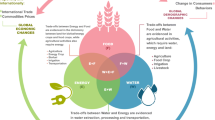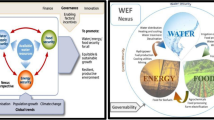Abstract
Water is considered the bloodstream of the biosphere, but its management is one of the most important challenges for human development. In view of the sustainable water management, several approaches have been proposed: Integrated Water Resources Management, Adaptive Management and, more recently, Water–Energy–Food (WEF) Nexus. Considering these approaches, over the last few decades, extensive efforts have been made to develop assessment methods and tools framed within the paradigm of sustainable development. As part of a holistic assessment of water resources, the recent approach based upon the WEF Nexus narrows down the consideration of intersectoral linkages to three dimensions that are of prominent interest, in particular in developing countries. This study presents a comprehensive indicator-based approach for the assessment of water, energy and food securities, with reference to the Sustainable Development Goals of the United Nations. The main ambition of the proposed approach is to provide a tool to monitor progresses, compare different geographical areas, highlight synergies and conflicts amongst and within the three dimensions of the WEF Nexus, and provide support for improved—more effective—management strategies to meet the goals. The proposed approach is demonstrated in the Ganges–Brahmaputra–Meghna (GBM) River Basin in Asia and to the Po River Basin in Europe. The comparative analysis suggests that WEF security is currently rather low in the GBM basin compared to the other case study and other parts of the world and allows the identification of which dimensions (indicators) require special attention on the part of local and global policy makers.


Similar content being viewed by others
Notes
http://www.un.org/ga/search/view_doc.asp?symbol=A/RES/70/1&Lang=E, last accessed 27 February 2016.
http://unsdsn.org/wp-content/uploads/2015/02/140522-SDSN-Indicator-Report-MAY-FINAL.pdf last accessed 4 May 2015.
http://unsdsn.org/wp-content/uploads/2015/03/150320-SDSN-Indicator-Report.pdf last accessed 4 May 2015.
The data and the spatial modelling procedure coded in the macro language of the TerrSet software can be obtained from authors upon request.
References
Abbasi T, Abbasi SA (2012) Chapter 10—Water-quality indices of USA and Canada. Elsevier, Amsterdam, pp 175–186. doi:10.1016/B978-0-444-54304-2.00010-5
Allan C, Xia J, Pahl-Wostl C (2013) Climate change and water security: challenges for adaptive water management. Curr Opin Environ Sustain 5:625–632. doi:10.1016/j.cosust.2013.09.004
Allen CR, Gunderson LH (2011) Pathology and failure in the design and implementation of adaptive management. J Environ Manag 92:1379–1384. doi:10.1016/j.jenvman.2010.10.063
Allen CR, Fontaine JJ, Pope KL, Garmestani AS (2011) Adaptive management for a turbulent future. J Environ Manag 92:1339–1345. doi:10.1016/j.jenvman.2010.11.019
Babel MS, Wahid SM (2008) Freshwater under threat South Asia: vulnerability assessment of freshwater resources to environmental change. United Nations Environment Programme, Nairobi
Bakker K (2012) Water security: research challenges and opportunities. Science 337:914–915. doi:10.1126/science.1226337
Beck M, Walker RV (2013) On water security, sustainability, and the water–food–energy-climate nexus. Front Environ Sci Eng 7:626–639. doi:10.1007/s11783-013-0548-6
Belton V, Stewart TJ (2002) Multiple criteria decision analysis: an integrated approach. Kluwer Academic Publishers, Boston
Benson D, Jordan A, Huitema D (2012) Involving the public in catchment management: an analysis of the scope for learning lessons from abroad. Environ Policy Gov 22:42–54. doi:10.1002/eet.593
Benson D, Gain AK, Rouillard JJ (2015) Water governance in a comparative perspective: from IWRM to a ‘nexus’ approach? Water Altern 8:756–773
Biswas AK (2008) Current directions: integrated water resources management—a second look. Water Int 33:274–278. doi:10.1080/02508060802272812
Bizikova L, Roy D, Swanson D, Venema HD, McCandless M (2013) The Water–Energy–Food Security Nexus: towards a practical planning and decision-support framework for landscape investment and risk management. Int Inst Sustain Dev, Manitoba
Bozzola M, Swanson T (2014) Policy implications of climate variability on agriculture: water management in the Po river basin, Italy. Environ Sci Policy 43:26–38. doi:10.1016/j.envsci.2013.12.002
Burrough PA, McDonnell RA, Lloyd CD (2015) Principles of geographical information systems, 3rd edn. Oxford University Press, Oxford
De Stefano L (2010) International initiatives for water policy assessment: a review. Water Resour Manag 24:2449–2466. doi:10.1007/s11269-009-9562-7
Eastman JR, Kyem PAK, Toledano J, Jin W (1993) Explorations in geographic systems technology volume 4: GIS and decision making. UNITAR, Geneva
Gain AK, Giupponi C (2015) A dynamic assessment of water scarcity risk in the Lower Brahmaputra River Basin: an integrated approach. Ecol Indic 48:120–131. doi:10.1016/j.ecolind.2014.07.034
Gain A, Apel H, Renaud F, Giupponi C (2013a) Thresholds of hydrologic flow regime of a river and investigation of climate change impact—the case of the Lower Brahmaputra river Basin. Clim Chang 120:463–475. doi:10.1007/s10584-013-0800-x
Gain AK, Rouillard JJ, Benson D (2013b) Can integrated water resources management increase adaptive capacity to climate change adaptation? A critical review. J Water Resour Prot 5:11–20. doi:10.4236/jwarp.2013.54A003
GFSI (2014) Global food security index 2014: an annual measure of the state of global food security. The Economist Intelligence Unit, London
Giupponi C, Fassio A, Feás J, Mysiak J (2006) Sustainable water management and decision making. In: Giupponi C, Jakeman AJ, Karssenberg D, Hare M (eds) Sustainable management of water resources: an integrated approach. E. Elgar, Cheltenhan, pp 71–97
GWP (2012) IWRM components. Global Water Partnership (GWP), Stockholm
Hering JG, Ingold KM (2012) Water resources management: What should be integrated? Science 336:1234–1235. doi:10.1126/science.1218230
Holling CS (1978) Adaptive environmental assessment and management. Wiley, New York
Hsu A, Emerson J, Levy M, de Sherbinin A, Johnson L, Malik O, Schwartz J, Jaiteh M (2014) The 2014 environmental performance index. Yale center for environmental law & policy, Yale University, New Haven, CT.
Huitema D, Mostert E, Egas W, Moellenkamp S, Pahl-Wostl C, Yalcin R (2009) Adaptive water governance: assessing the institutional prescriptions of adaptive (co)management from a governance perspective and defining a research agenda. Ecol Soc 14(1):26
IIASA/FAO (2012) Global Agro‐ecological Zones (GAEZ v3.0). IIASA, Laxenburg, Austria and FAO, Rome, Italy
Immerzeel WW, Bierkens MFP (2012) Asia’s water balance. Nat Geosci 5:841–842. doi:10.1038/ngeo1643
International Council for Science I (2002) Making science for sustainable development more policy relevant: new tools for analysis. ICSU Series on Science for Sustainable Development No. 8
Kaufmann D, Kraay A, Mastruzzi M (2010) The worldwide governance indicators: methodology and analytical issues World Bank Policy Research Working Paper No. 5430. Available at: http://ssrn.com/abstract=1682130
Kumar P, Bansod BKS, Debnath SK, Thakur PK, Ghanshyam C (2015) Index-based groundwater vulnerability mapping models using hydrogeological settings: a critical evaluation. Environ Impact Assess Rev 51:38–49. doi:10.1016/j.eiar.2015.02.001
Marchina C, Bianchini G, Natali C, Pennisi M, Colombani N, Tassinari R, Knoeller K (2015) The Po river water from the Alps to the Adriatic Sea (Italy): new insights from geochemical and isotopic (δ18O-δD) data. Environ Sci Pollut Res 22:5184–5203. doi:10.1007/s11356-014-3750-6
Medema W, McIntosh BS, Jeffrey PJ (2008) From premise to practice: a critical assessment of integrated water resources management and adaptive management approaches in the water sector. Ecol Soc 13(2):29
Milly PCD, Betancourt J, Falkenmark M, Hirsch RM, Kundzewicz ZW, Lettenmaier DP, Stouffer RJ (2008) Stationarity is dead: Whither water management? Science 319:573–574. doi:10.1126/science.1151915
Oelkers EH, Hering JG, Zhu C (2011) Water: Is there a global crisis? Elements 7:157–162
Oki T, Kanae S (2006) Global hydrological cycles and world water resources. Science 313:1068–1072. doi:10.1126/science.1128845
Olsson G (2013) Water, energy and food interactions—challenges and opportunities. Front Environ Sci Eng 7:787–793. doi:10.1007/s11783-013-0526-z
Organisation for Economic Co-operation and Development (1991) Environmental indicators—a preliminary set. OECD, Paris
Organisation for Economic Co-operation and Development (1994) Environmental indicators—OECD core set. OECD, Paris
Pahl-Wostl C, Sendzimir J, Jeffrey P, Aerts J, Berkamp G, Cross K (2007) Managing change toward adaptive water management through social learning. Ecol Soc 12(2):30
Pahl-Wostl C, Jeffrey P, Isendahl N, Brugnach M (2011) Maturing the new water management paradigm: progressing from aspiration to practice. Water Resour Manage 25:837–856. doi:10.1007/s11269-010-9729-2
Pahl-Wostl C, Vörösmarty C, Bhaduri A, Bogardi J, Rockström J, Alcamo J (2013) Towards a sustainable water future: shaping the next decade of global water research. Curr Opin Environ Sustain 5:708–714. doi:10.1016/j.cosust.2013.10.012
Palmeri L, Bendoricchio G, Artioli Y (2005) Modelling nutrient emissions from river systems and loads to the coastal zone: Po River case study, Italy. Ecol Model 184:37–53. doi:10.1016/j.ecolmodel.2004.11.007
Pedro-Monzonís M, Solera A, Ferrer J, Estrela T, Paredes-Arquiola J (2015) A review of water scarcity and drought indexes in water resources planning and management. J Hydrol 527:482–493. doi:10.1016/j.jhydrol.2015.05.003
Postel SL, Daily GC, Ehrlich PR (1996) Human appropriation of renewable fresh water. Science 271:785–788
Rasul G (2015) Water for growth and development in the Ganges, Brahmaputra, and Meghna basins: an economic perspective. Int J River Basin Manag. doi:10.1080/15715124.2015.1012518
Rouillard JJ, Benson D, Gain AK (2014) Evaluating IWRM implementation success: Are water policies in Bangladesh enhancing adaptive capacity to climate change impacts? Int J Water Resour Dev. doi:10.1080/07900627.2014.910756
Savenije HHG, Van der Zaag P (2008) Integrated water resources management: concepts and issues. Phys Chem Earth Parts A/B/C 33:290–297. doi:10.1016/j.pce.2008.02.003
Schmucker KJ (1983) Fuzzy sets, natural language computations, and risk analysis. Computer Science Press, Rockville
Singh BK (2013) South Asia energy security: challenges and opportunities. Energy Policy 63:458–468. doi:10.1016/j.enpol.2013.07.128
Srebotnjak T, Carr G, de Sherbinin A, Rickwood C (2012) A global Water Quality Index and hot-deck imputation of missing data. Ecol Indic 17:108–119. doi:10.1016/j.ecolind.2011.04.023
Stocker TF et al (2013) Climate Change 2013: The Physical Science Basis. Contribution of Working Group I to the Fifth Assessment Report of the Intergovernmental Panel on Climate Change. Cambridge University Press, Cambridge and New York
UN-WWAP (2009) Water in a changing world the world water development report series. United Nations World Water Assessment Programme. UNESCO, Paris
UN-WWAP (2012) Water in a changing world the world water development report series. United Nations World Water Assessment Programme. UNESCO, Paris
Vörösmarty CJ, Pahl-Wostl C, Bunn SE, Lawford R (2013) Global water, the anthropocene and the transformation of a science. Curr Opin Environ Sustain 5:539–550. doi:10.1016/j.cosust.2013.10.005
Wada Y, van Beek LPH, Sperna Weiland FC, Chao BF, Wu Y-H, Bierkens MFP (2012) Past and future contribution of global groundwater depletion to sea-level rise. Geophys Res Lett 39:L09402. doi:10.1029/2012GL051230
Wada Y, van Beek LPH, Wanders N, Bierkens MFP (2013) Human water consumption intensifies hydrological drought worldwide. Environ Res Lett 8:034036. doi:10.1088/1748-9326/8/3/034036
WEC (2013) World Energy Trilemma: 2013 Energy Sustainability Index. World Energy Council, London
Yang YCE, Wi S, Ray PA, Brown CM, Khalil AF (2016) The future nexus of the Brahmaputra River Basin: climate, water, energy and food trajectories. Glob Environ Chang 37:16–30. doi:10.1016/j.gloenvcha.2016.01.002
Acknowledgments
The research presented in this paper was developed within the Leverhulme Trust Project ‘Integrated Water Resources Management as an approach for Climate Change Adaptation: comparative lesson drawing’. AK Gain is supported by Alexander von Humboldt Foundation, which is gratefully acknowledged.
Author information
Authors and Affiliations
Corresponding author
Rights and permissions
About this article
Cite this article
Giupponi, C., Gain, A.K. Integrated spatial assessment of the water, energy and food dimensions of the Sustainable Development Goals. Reg Environ Change 17, 1881–1893 (2017). https://doi.org/10.1007/s10113-016-0998-z
Received:
Accepted:
Published:
Issue Date:
DOI: https://doi.org/10.1007/s10113-016-0998-z




